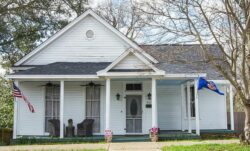
Image: Jackson Free Press
“The urns weren’t memorials. They were storage. They were the remains family members did not wish to acknowledge. They were the ashes of dying men who returned to Mississippi to live out their lives, only to discover their families would not permit anyone living with AIDS, even kin, into their homes.” — Brian Gordon, Jackson Free Press
In 1985, Sandifer House, a one-story home on North Jefferson Street in Jackson, Mississippi, opened to those living with AIDS. It opened at the height of the AIDS crisis, when fear and paranoia replaced care and concern. It was a time when Levi Strauss & Co. supported HIV/AIDS efforts when few institutions would step up.
The first known HIV-positive patient in Mississippi was treated at the University of Mississippi Medical Center (UMMC) in the early 1980s and survived only a few days. By 1985, when Sandifer House opened, more people living with HIV were returning to their home state, but the stigma around the disease left them homeless as families shunned them and the government remained silent.
Mississippi’s gay community recognized that the care they needed could only come from their own. That’s when Eddie Sandifer, a longtime activist and head of the Mississippi Gay and Lesbian Alliance, used his skills as a nursing home administrator to open his home to care for those living with AIDS.
According to Kendall Comish, a graduate student at Mississippi State University, Levi Strauss & Co. was the only large company to donate to Sandifer House. It was a surprising link he discovered while researching Sandifer’s story recently. “It was an awesome thing,” Kendall shared with me in an email.
From the inception of the disease, LS&Co. was a leader in corporate efforts to reduce stigma around the disease. In 1982, for example, the Levi Strauss Foundation provided the first corporate donation to the Kaposi Sarcoma Clinic at San Francisco General Hospital, the first AIDS clinic in the world.
LS&Co. executives joined employees the same year to fight stigma about the disease at its headquarters in San Francisco. Future CEO Bob Haas and other executives stood with employees handing out educational flyers in the Atrium at Levi’s® Plaza. It was the first of many efforts to combat the disease, which included raising funds for AIDS research, being a dominant presence at AIDS walks each year and helping those suffering with AIDS — like the residents of Sandifer House.
LS&Co.’s support of Sandifer House likely came through the company’s Customer Service Center in Canton, Mississippi, which opened in 1982.
The Mississippi Gay and Lesbian Alliance rented Sandifer’s large white Mississippi home in 1985 and welcomed the first residents in spring 1986. Twelve residents occupied the house at any time with shared rooms. The residents were mostly young men in their 20s and 30s. Eddie Sandifer provided transportation to UMMC for testing and picked up new long-term residents at night when it was discreet. Nighttime drop-offs were also a security measure. “Neighbors threatened to burn down one person’s home … when they found out he was positive,” Sandifer once told a reporter.
Residents played cards, cooked or watched television. When their conditions grew dire, Sandifer and those well enough to assist cared for them. A vacancy when one resident passed was quickly filled.
The local gay community also helped cover costs. One owner of a restaurant charged a $1 cover for years, giving the proceeds to the alliance. No funding came from a single government agency.
Sandifer House closed in 1992, and Eddie Sandifer passed away in 2016. Recalling the lives of Sandifer’s residents and the contributions of activists like Eddie, supported in part by LS&Co., remains a moving memory.







